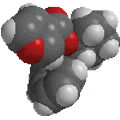 |
Chapter 11 : Arenes and Aromaticity |
 |
Aromaticity
- Aromaticity is the property
associated with the significant extra stability of certain types of π systems. Such systems are said to be "aromatic".
- Fundamentally, aromaticity arises
from having the maximum number of electrons in the pi bonding molecular orbitals.
As we will see, it is not restricted to benzene, substituted benzenes, 6-membered
rings or just even hydrocarbons.
- The property of aromaticity is
generally due to the significant extra stability
associated with a resonance delocalised structure.
- This extra stability moderates
the reactivity of these systems compared to alkenes and means aromatics can,
and should be considered to be their own functional group.
- The presence of aromatic systems
can also influence the reactivity of functional groups directly attached to
the aromatic system, particularly in the benzylic position. Therefore, it is
important that you are able to recognise the aromatic systems.
Classifications
We will review how to identify which classification applies later in this chapter. We are just defining the terms here:
- Compounds that have this significant extra stability are said to be "aromatic" e.g. benzene.
- Compounds that don't have extra stability and just have normal stability are "non-aromatic" e.g. cyclohexene or 1,3-cyclohexadiene.
- Compounds that are unusually unstable due to their pi system are said to be "anti-aromatic" e.g. 1,3-cyclobutadiene